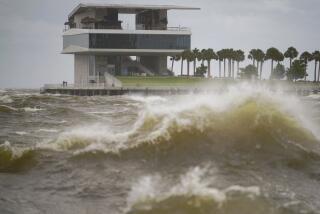Forecasters Track Hurricane’s Path : Computers Are Given Data in Hectic Effort to Predict Next Target
MIAMI — Hurricane Hugo was spinning on a northwesterly course late Tuesday, sparing the southern Bahamas but moving foursquare toward the more ample target of the United States, with landfall probable in the next few days.
Exactly where? No one was certain--at least not yet. “What we know for sure right now is that we don’t know,” said forecaster Noel Risnychok of the National Hurricane Center here in Miami.
The tempest could strike as far south as Key West or drift up as high as Cape Hatteras in North Carolina. Then again, Hugo could even take a turn back out to sea, sputtering to a forgettable death in the North Atlantic.
Sifting Clues
The elite meteorologists sifted the clues in their hectic offices. They studied data from coastal radar stations and far-flung satellites. Their spotter planes ventured right into Hugo’s eye, probing inside and out.
Then they fed the measurements to computers to answer: What will happen when the storm bumps into other weather systems? Where have other hurricanes ended up after making similar runs across the Caribbean?
“It’ll take another day before we begin to narrow down the odds,” Risnychok said. “Right now, I’ve got six computer models sitting in front of me, and they fan out from Florida to the Carolinas.”
A hurricane is a peculiar blend of heat, winds, moisture and atmospheric pressure. Think of it as an engine running on the vapor that it extracts from the warm sea below.
Needs Water to Survive
The whirlwind needs that water to survive. Without it, it starves. With it, it has nourishment to replenish itself until the friction of a brush with land drags it apart.
Something as small as Puerto Rico was nothing to Hugo. All those bony islands it has trampled so far--some no more than flyspecks--have been less hindrance than a knee-high fence.
Hugo may have weakened from 140 to 105 m.p.h., but was back now over the open sea where it can gather strength.
In its path there were very few winds aloft to affect its direction. Only one low pressure system lay ahead.
On Tuesday, that air was stationary and should it remain so, the hurricane will probably continue its northwesterly path and trudge on toward the Georgia coast or points north.
But if this weather trough moves back to the west, from which it came, then it will probably pull Hugo along with it--smack into Florida’s mid-section.
Late Tuesday, the forecasters--when pressed--leaned toward the first possibility, hedging as always. It was too soon to tell.
“The probabilities are increasing the most for the Savannah and Charleston areas, and we’ll probably put up a hurricane watch in those places tomorrow,” said Bob Sheets, head of the hurricane center.
All this uncertainty has forced cities for 1,000 miles to take precautions. Shelters were stocked with food and cots. Civil defense workers reviewed evacuation plans. Hot-line numbers flashed across television screens.
Some Sun Left
In the Bahamas, tourists enjoyed a peek-a-boo sun and seemed grateful Hugo had not become their spoiler. Still, hotel managers took steps to counter the storm, should it wobble their way.
Bill Naughton, manager of the historic British Colonial Hotel in Nassau, told his gardeners to trim the palm trees that surround the grounds. “Flying coconuts can be very dangerous in a storm,” he explained.
HURRICANE HUGO
POSSIBLE LANDFALLS
Weather forecasters give Hurricane Hugo a better than 50% chance of crossing the U.S. coastline by the end of the week, with the greatest probability being around central Florida.
THE AFTERMATH
1. Guadeloupe--Five dead, 84 injured, more than 15,000 homeless on the French territory.
2. Montserrat--Six dead, hundreds of buildings flattened on the British island. Nearly all of the 12,000 residents left homeless.
3. Antigua--Two dead, widespread wind and rain damage.
4. Virgin Islands--Numerous injuries on the British Virgin island of Tortola, and scores of homes destroyed. U.S. Virgin Islands of St. Thomas and St. Croix hard hit, widespread looting reported.
5. Puerto Rico--Twelve reported dead, many thousands homeless. Water and electricity cut off, food shortages reported, and National Guard called out to stem looting.
More to Read
Sign up for Essential California
The most important California stories and recommendations in your inbox every morning.
You may occasionally receive promotional content from the Los Angeles Times.










